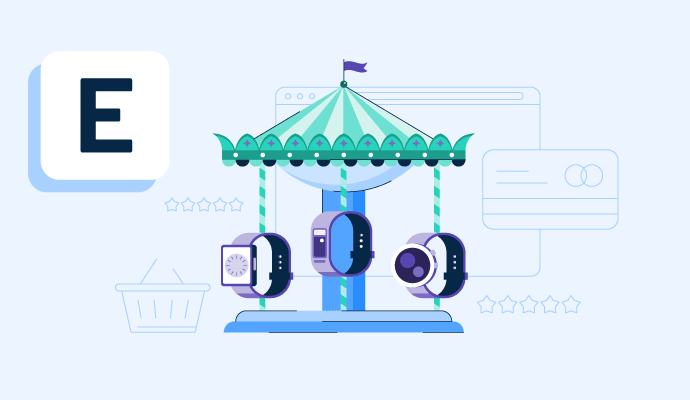What is e-commerce?
E-commerce is the buying and selling of products and services over the internet. A shortened form of the phrase “electronic commerce,” e-commerce encompasses any purchase transaction on a web page or mobile app.
With advances in technology, it’s easier than ever for online businesses to market and sell their wares – and equally as easy for consumers to find just about any item they seek. For example, if they can’t locate a vintage record or handmade mug at nearby brick-and-mortar stores, they can browse e-commerce sites.
Instead of building their own online retail site, many entrepreneurs turn to ready-to-go e-commerce platforms. The software provides an all-in-one solution with customer-facing product pages and built-in payment options.
Types of e-commerce
An abundance of types of brick-and-mortar stores exist, from small jewelry stores to industrial machinery sellers, and the same is true for e-commerce stores. These businesses typically fall into one of five categories.
- Business-to-consumer (B2C). One of the most common types of e-commerce, B2C, refers to the method of a business selling to the end user. For example, an online store with outdoor gear sells directly to consumers who need the company’s tents and jackets.
- Business-to-business (B2B). Companies often sell to other companies. For instance, a software-as-a-service (SaaS) company that sells payroll software markets to businesses with multiple employees.
- Direct-to-consumer (D2C). In this model, also known as DTC, manufacturers bypass retailers and sell their own products through a website. For instance, shoppers can buy mattresses directly from some manufacturers instead of from a mattress outlet or department store.
- Consumer-to-consumer (C2C). Some e-commerce platforms, like Etsy, allow consumers to buy from other consumers. In this model, individuals can sell items like antique blankets or handmade ornaments directly to other individuals.
- Consumer-to-business (C2B). Individuals sometimes sell services or products to businesses. For example, a travel blogger might offer to review and link to a hotel chain for a fee or free hotel stay.
Basic elements of e-commerce websites
E-commerce stores strive to offer the same personalized shopping experiences as brick-and-mortar stores. To do this, their sites must go beyond basic features to also provide:
- Branding. As businesses that strive to build loyal customers, e-commerce sites need prominent brand elements like logos and predictable color palettes and fonts. These elements carry through to the company’s mobile apps and social media to create a consistent omnichannel experience.
- Search features. Whereas brick-and-mortar retailers can strategically place salespeople to assist customers, e-commerce websites rely on a search bar to guide customers to what they’re looking for. Some e-commerce stores take an extra step and offer a live chat function to answer product and store policy questions.
- Product description. Whether companies are selling physical products, digital products, or services, they need to provide a detailed written description of what their offer entails. Sometimes these descriptions are in paragraph form, and sometimes they are provided as bulleted lists.
- Product images. High-quality images are a staple of e-commerce sites. On a B2B SaaS site, this might simply be images of the software in use. On an apparel site, this might include various images of a shirt from all angles. Many e-commerce sites now also use videos of a product in use.
- Shopping cart and checkout. E-commerce retailers use a digital shopping cart system. Customers select a quantity of a product or service to add to the cart. Then, they can click on the shopping cart icon to access all the products they’ve added and check out. The checkout process asks the customer to add information like their address and payment details.
Benefits of e-commerce
Customers like e-commerce stores because of the convenience of shopping from home and the variety of products. E-commerce can also provide advantages to individuals and companies who choose to sell online.
- Greater reach. A brick-and-mortar location is limited to customers within its geographic area. An e-commerce shop in that same industry can reach customers worldwide or wherever their payment and shipping providers work.
- Lower overhead. With an e-commerce storefront, companies reduce their operational costs. They don’t have to pay rent or utilities for a physical store, and they don’t have to pay employees to manage and monitor the business. Typically, an e-commerce store owner pays for a domain, website hosting, and payment platform fees. They may also pay subscription fees to a SaaS e-commerce platform. Either way, the cost is much lower than maintaining a physical location.
- More effective marketing. E-commerce sellers can use web analytics software that allows them to learn where their visitors come from, how long they stay on the site, and which pages interest them the most. Businesses use this data to create campaigns like pay-per-click (PPC) ads that will target customers most effectively.
E-commerce best practices
E-commerce stores range from small independent soap makers to expansive marketplaces like Amazon. No matter the type of e-commerce store they have, business owners should follow these best practices.
- Know the target audience. Knowing shoppers’ demographics, preferences, and interests helps with everything from designing the right branding and user interface (UI) to choosing inventory and determining which services to bundle. Companies gather consumer data and survey users to collect feedback.
- Optimize for search engines. E-commerce stores use search engine optimization (SEO) to improve their website for search engines with the right page titles, descriptions, and keywords. SEO helps attract more traffic to an e-commerce website.
- Expand marketing. Advertising and marketing for an e-commerce site take multiple forms. In addition to PPC ads, an online retailer might use pop-ups, affiliate marketing, and influencers on various social media platforms to sell their products.
- Improve the user interface (UI) and user experience (UX). An e-commerce seller should reduce friction in the customers’ journey from arrival to purchase. They can do this by using clear UI features like menus, layouts, and call-to-action buttons that will improve the overall user experience (UX).
Browse e-commerce tools to create an effortless e-commerce experience for you and your customers.

Kelly Fiorini
Kelly Fiorini is a freelance writer for G2. After ten years as a teacher, Kelly now creates content for mostly B2B SaaS clients. In her free time, she’s usually reading, spilling coffee, walking her dogs, and trying to keep her plants alive. Kelly received her Bachelor of Arts in English from the University of Notre Dame and her Master of Arts in Teaching from the University of Louisville.



